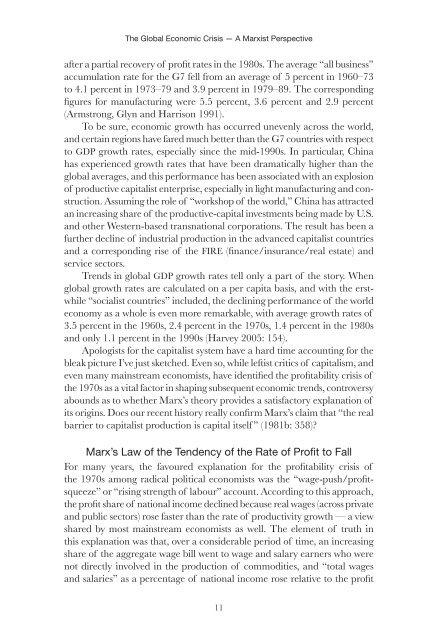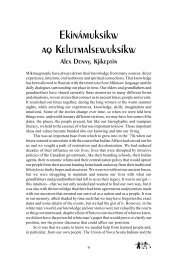The Global Economic Crisis — A Marxist Perspective - Fernwood ...
The Global Economic Crisis — A Marxist Perspective - Fernwood ...
The Global Economic Crisis — A Marxist Perspective - Fernwood ...
Create successful ePaper yourself
Turn your PDF publications into a flip-book with our unique Google optimized e-Paper software.
<strong>The</strong> <strong>Global</strong> <strong>Economic</strong> <strong>Crisis</strong> <strong>—</strong> A <strong>Marxist</strong> <strong>Perspective</strong><br />
after a partial recovery of profit rates in the 1980s. <strong>The</strong> average “all business”<br />
accumulation rate for the G7 fell from an average of 5 percent in 1960–73<br />
to 4.1 percent in 1973–79 and 3.9 percent in 1979–89. <strong>The</strong> corresponding<br />
figures for manufacturing were 5.5 percent, 3.6 percent and 2.9 percent<br />
(Armstrong, Glyn and Harrison 1991).<br />
To be sure, economic growth has occurred unevenly across the world,<br />
and certain regions have fared much better than the G7 countries with respect<br />
to gdp growth rates, especially since the mid-1990s. In particular, China<br />
has experienced growth rates that have been dramatically higher than the<br />
global averages, and this performance has been associated with an explosion<br />
of productive capitalist enterprise, especially in light manufacturing and construction.<br />
Assuming the role of “workshop of the world,” China has attracted<br />
an increasing share of the productive-capital investments being made by U.S.<br />
and other Western-based transnational corporations. <strong>The</strong> result has been a<br />
further decline of industrial production in the advanced capitalist countries<br />
and a corresponding rise of the fire (finance/insurance/real estate) and<br />
service sectors.<br />
Trends in global gdp growth rates tell only a part of the story. When<br />
global growth rates are calculated on a per capita basis, and with the erstwhile<br />
“socialist countries” included, the declining performance of the world<br />
economy as a whole is even more remarkable, with average growth rates of<br />
3.5 percent in the 1960s, 2.4 percent in the 1970s, 1.4 percent in the 1980s<br />
and only 1.1 percent in the 1990s (Harvey 2005: 154).<br />
Apologists for the capitalist system have a hard time accounting for the<br />
bleak picture I’ve just sketched. Even so, while leftist critics of capitalism, and<br />
even many mainstream economists, have identified the profitability crisis of<br />
the 1970s as a vital factor in shaping subsequent economic trends, controversy<br />
abounds as to whether Marx’s theory provides a satisfactory explanation of<br />
its origins. Does our recent history really confirm Marx’s claim that “the real<br />
barrier to capitalist production is capital itself ” (1981b: 358)?<br />
Marx’s Law of the Tendency of the Rate of Profit to Fall<br />
For many years, the favoured explanation for the profitability crisis of<br />
the 1970s among radical political economists was the “wage-push/profitsqueeze”<br />
or “rising strength of labour” account. According to this approach,<br />
the profit share of national income declined because real wages (across private<br />
and public sectors) rose faster than the rate of productivity growth <strong>—</strong> a view<br />
shared by most mainstream economists as well. <strong>The</strong> element of truth in<br />
this explanation was that, over a considerable period of time, an increasing<br />
share of the aggregate wage bill went to wage and salary earners who were<br />
not directly involved in the production of commodities, and “total wages<br />
and salaries” as a percentage of national income rose relative to the profit<br />
11





